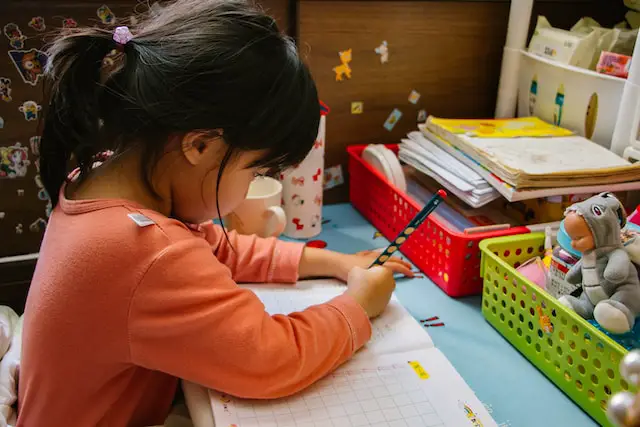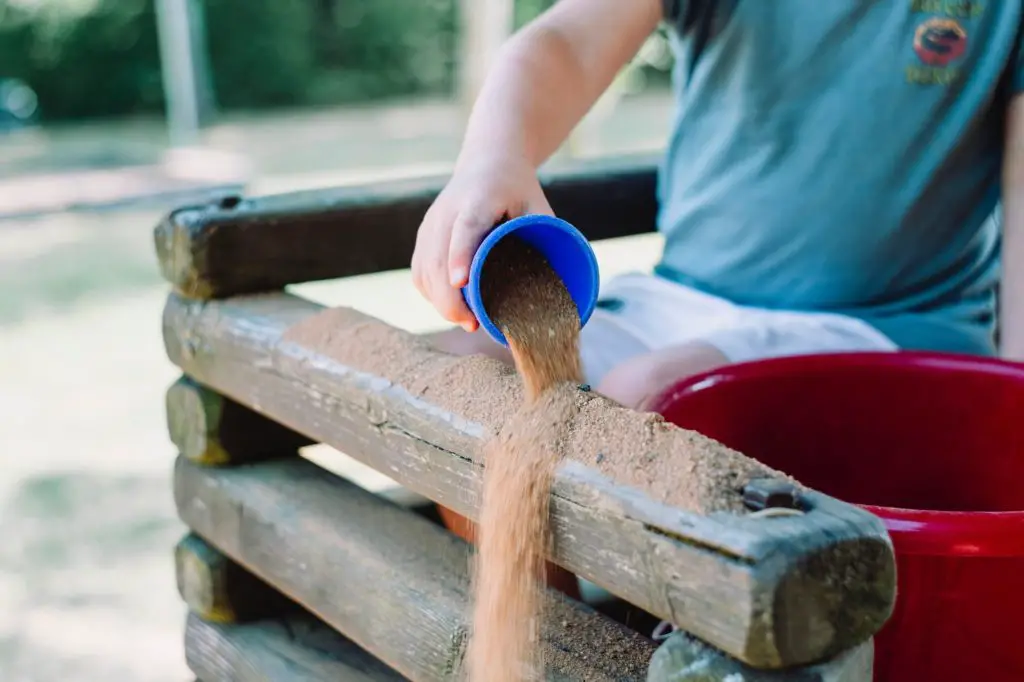Crossing the midline is a critical developmental milestone in young children. Essentially, it refers to the ability to move one’s arm, hands, legs, or eyes over the imaginary line that divides the body into left and right halves, called midline. The brain coordinates the movement across the corpus callosum, the large bundle of neural fibers connecting the two cerebral hemispheres and facilitating interhemispheric communication.
The ability to cross the midline indicates that both brain hemispheres communicate and share information effectively. It is vital in building brain pathways that promote coordinated use of both sides of the body. Crossing the midline is fundamental for daily cognitive and physical tasks. Reading, writing, coordination for sports, and self-care skills require fluid movements of the left and right sides of the body.

Reading and Writing: Comfortably moving eyes and hands from one side of the body to another is crucial for reading and writing. Both tasks require the ability to track from left to right smoothly. Children who struggle with crossing the midline will find it challenging to read a line of text or write across a page without switching hands or making unnatural movements.
Coordination, Fine and Gross Motor Skills: Tasks that require coordination, like crawling, jumping, and dancing, often involve crossing the midline. Fine motor skills (such as cutting with scissors or coloring) and gross motor skills (such as reaching or catching a ball) depend on how comfortably children can cross the midline. Furthermore, crossing the midline sets the stage for learning more complex coordination tasks later in life, such as swinging a bat in baseball or dribbling a basketball.
Self-care skills: Many everyday tasks, like brushing teeth, combing hair, and getting dressed, require crossing the midline. As children develop this skill, they will become more independent and efficient in their daily routines.
Development Stages of Crossing Midline
Infancy (0-12 months)
- 0-3 Months/Spontaneous Movements: Infants primarily display reflexive, involuntary movements. Newborns are learning to control their movements.
- 4-6 Months/Limited Independent Movements: Babies begin to reach for objects but still generally use the hand on the same side as the object they’re getting for (i.e., they don’t yet cross the midline).
- 6-12 Months/Independent Movements Develop: As infants become more mobile, they might occasionally cross the midline during activities like rolling over, crawling, or reaching for objects across their bodies.

Toddlerhood (1-3 years)
- 1-2 Years/Emergence of Dominance: Toddlers use both sides of their bodies more symmetrically as they learn to walk. However, many toddlers still prefer using one side of the body for tasks. Early signs of hand preference may emerge, but switching between hands is not unusual. Some may begin to cross the midline during play, but many still rely primarily on one side of the body for tasks.
- 2-3 Years/Inconsistent Midline Crossing: During this period, toddlers become more coordinated and may start to cross the midline during activities like drawing, even though they may not do so consistently. Activities like dancing, running, and playing promote crossing the midline, but some children might still avoid it.
Preschool Age (3-5 years)
- Early Preschool/Improved Coordination: Children of this age can usually engage in activities that naturally involve crossing the midline, such as turning the pages of a book or scribbling across a large piece of paper.
- Late Preschool/Hand Dominance/Refined Motor Skills: Children are more adept at activities requiring the coordinated use of both hands, such as cutting with scissors, drawing shapes, or playing ball games. Many children start showing a consistent preference for one hand. There are increasing instances of smooth, spontaneous midline crossing.

Early School Age (5-7 years)
- Consistent Hand Dominance: Most children should be comfortable crossing the midline by this age. Hand dominance is defined.
- Complex Tasks: Children perform more complex motor tasks that require crossing the midline, such as tying shoes, writing, and playing sports like basketball and soccer. Furthermore, children perform intricate tasks such as reading, which requires moving their eyes from left to right.
Later School Age (7 years and beyond)
- Mastery: By now, crossing the midline is a well-established skill. At this stage, children engage in activities requiring rapid, coordinated movements across the midline, like playing musical instruments, participating in advanced sports, and writing more fluently.
Developmental Concerns
Every child develops at their own pace. The ability to cross the midline develops when children grow and become more coordinated. Some variations are typical and not necessarily indicative of developmental challenges. However, if a child consistently avoids crossing the midline, it may be reason for concern. It is always best to consult a pediatrician or developmental specialist, such as an occupational therapist, for comprehensive evaluation.

Why is my child not crossing the midline?
Delayed Milestones: The child needs more time to develop skills. The child displays delays in motor skills, including fine and gross motor skills. Additionally, the child might exhibit difficulty with speech and language development.
Sensory Processing Difficulties: Children with sensory processing difficulties might avoid or have trouble with tasks that involve crossing the midline. Planning and executing movements crossing the midline might be challenging.
School Difficulties: Difficulty crossing the midline can manifest in a school setting. Teachers or caregivers report concerns regarding the child’s motor skills or coordination. Handwriting, reading, or participating in physical activities might be puzzling.
Vision Concerns: Sometimes, children with vision issues might have difficulty with tasks involving crossing the midline.
Neurological Concerns: The brain’s left and right sides of the brain must communicate to execute coordinated movements. Brain hemispheres may lack effective neural connections. A child’s ability to cross the midline might be affected if the brain pathways do not share information adequately.
Unusual Behaviors: If a child seems to be compensating for not crossing the midline by turning their whole body to perform tasks or appears awkward and uncoordinated in their movement, it could be an indication for further assessment.
Parental Instinct: Sometimes, parental instinct is a powerful signal to seek professional advice. Following the parental instinct to pursue comprehensive evaluation and potentially target intervention never hurts. Early diagnosis and intervention often result in better outcomes.
It is crucial to avoid jumping to conclusions based on one or a few observations. If the concerns persist, consult a pediatrician for an assessment. The pediatrician may refer the child to an occupational therapist, who can perform more specific evaluations and recommend appropriate therapeutic activities to help your child develop the necessary skills.

Activities that Promote Crossing the Midline
Physical Activities
Simon Says: Play “Simon Says” with actions that involve crossing the midline, like touching opposite elbows and knees or tapping the opposite shoulder.
Bean Bag Toss: Toss bean bags, softballs, or rings to a target on the opposite side.
Windmill Stretches: Stand with arms and legs wide, then reach down with one hand to touch the opposite foot and alternate.
March and Tap: March in place or around the room, lifting knees high and tapping the opposite knee with the opposite hand as they march.
Hula Hoop: Swirling a hula hoop around the waist or limbs engages both sides of the body and encourages midline crossing.
Obstacle Course: Create an obstacle course where the child crawls under tables or through tunnels, naturally encouraging them to cross the midline.
Crab Walk: Walking like a crab enables crossing the midline as one hand and the opposite foot move simultaneously. Moreover, practice various animal walks, swim like a fish, or stop like an elephant. Please check out the Fun Animal Walks Action Cards.
Sports: Basketball or soccer dribbling often encourages moving the ball from one side of the body to the other. Baseball, tennis, and golf require more intricate coordination moves. As well, martial arts provide excellent left and right-side coordination.

Arts and Crafts
Playdough: Encourage your child to roll out playdough into long snakes and then use both hands to twist them together. Playdough Obsession: Easy and Fun Playdough Activities.
Drawing: Use large sheets of paper and have kids draw big circles or figure eights with crayons, crossing from one side to the other.
String Beads: Bead stringing not only works on fine motor skills but also has kids crossing the midline as they pick up beads from both sides.
Painting: Encourage children to paint on a large canvas or paper, reaching across the midline to apply colors.
Sidewalk Chalk: Have fun with sidewalk chalk. Ensure children use their arms and cross over to the other side of the body.
Crafts: Cutting with scissors, gluing, and manipulating craft materials requires skilled coordination.

Music and Rhythm
Drumming: Have your child drum on pots and pans, encouraging them to reach across their body to drum on the far containers.
Clapping Games: “Pat-a-cake” or “Miss Mary Mack” and other clapping games can help children practice crossing their midline.
Scarf Dance: Hold one or two floaty scarf waves in the air in multiple directions. Play fun music and make circles, lines, zigzags, crosses, figure eights, and other shapes.
Dance: Encourage moves that require reaching across the body or spinning in both directions.

Puzzles and Games
Floor Puzzle: Large floor puzzles often require children to reach across their bodies to put pieces in place. 5 Powerful ReasonsPuzzles Skyrocket Child Development
Pass the Ball: Sit in a circle and use both hands to pass a ball around the circle, requiring each child to reach across their body to receive and pass the ball. Pass the Potato Game is super fun.
Board Games: Board games often require players to reach across to move pieces and encourage crossing actions.
Everyday Activities
Cooking: Stirring a bowl of ingredients can help you practice crossing the midline. Fun pretend cooking activities are also an excellent option for younger children.
Getting Dressed: Putting on a coat or pulling up pants encourages children to cross the midline.
Cleaning: Sweeping, wiping down surfaces, washing windows or cars in a side-to-side motion encourages crossing the midline. Cleaning set for toddlers and preschoolers.
Reading: Tracking with a dinger from the side of a page to the other facilities crossing the midline.
Gardening: Actions like digging, planting, and watering promote crossing the midline while alternating or reaching across the body. Gardening set for toddlers and preschoolers.
These activities are generally safe for young children; however, adult supervision is advised to ensure children perform the movements safely and correctly.

Summary
Crossing the midline is a critical developmental milestone reflecting the integration and communication between the brain’s two hemispheres. The ability to spontaneously cross the midline with the arms, legs, and eyes strongly indicates that both sides of the brain effectively communicate and share information. The ability to cross the midline suggests a maturing brain, therefore, predicts the capacity to perform complex, fluid, and coordinated movements across myriad environments.
Early childhood represents a critical time for the ability to cross the midline. Although the brain can always learn and change, early childhood (0-7 years) is a sensitive period for developing various motor and cognitive skills, including crossing the midline. During these years, the brain is rapidly receptive and responsive to experiences. New neural connections are developed quickly, and foundational skills are being established.
If a young child has difficulty crossing the midline, it is beneficial to consult a professional. Early therapeutic interventions tailored to a child’s needs positively influence foundational skills development. Mastery of crossing the midline can impact the ease with which the subsequent abilities are learned. Successfully crossing midline at a young age can influence the outcome of reading, writing, and many other coordination tasks.
If you enjoyed this article, please share it with a friend!
Why are Gross Motor Skills Important for Fine Motor Success
Fun Animal Walk Exercises for Children
Playdough Obsession, Fun and Easy Activities for Kids
Nature Play – 7 Benefits for Child’s Growth
Powerful Sensory Integration in Children
10 Reasons Block Play is Essential for Children
5 Reasons Puzzles Skyrocket Child Development
Discover Why Messy Play is Important
*Kids Groove and Grow participates in the Amazon Services LLC Associates Program, an affiliate advertising program designated to provide means for sites to earn advertising fees by advertising and linking to Amazon.com.


0 Comments